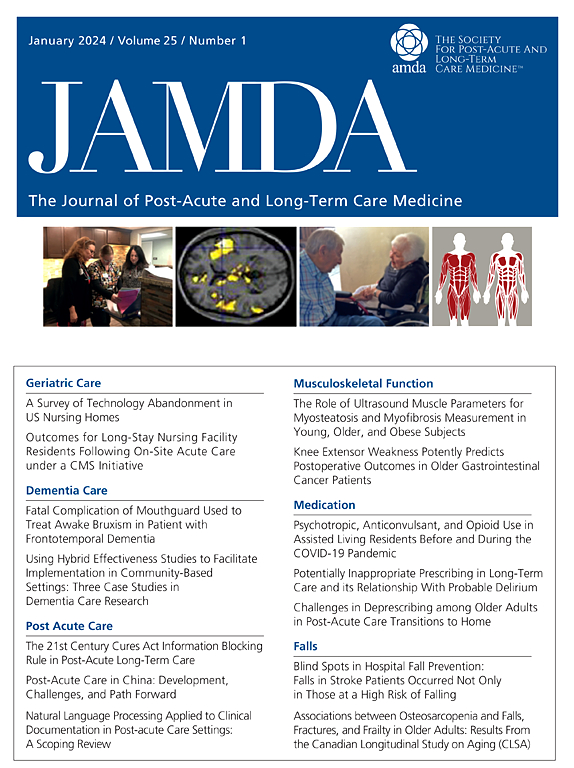Cross-National Evidence on Risk of Death Associated with Loneliness: A Survival Analysis of 1-Year All-Cause Mortality among Older Adult Home Care Recipients in Canada, Finland, and Aotearoa | New Zealand
IF 4.2
2区 医学
Q2 GERIATRICS & GERONTOLOGY
Journal of the American Medical Directors Association
Pub Date : 2025-06-04
DOI:10.1016/j.jamda.2025.105687
引用次数: 0
Abstract
Objectives
To examine all-cause 1-year risk of mortality associated with loneliness for home care recipients after adjusting for potential confounders.
Design
Survival analyses with parallel designs using interRAI Home Care assessments and mortality.
Settings and Participants
Home care recipients in 3 countries—Canada, Finland, and Aotearoa | New Zealand (ANZ)—who were 65 years and older were selected for this retrospective analysis.
Methods
We fit a multivariable Cox regression model to obtain the adjusted proportional hazards of 1-year mortality among home care recipients for each of the 3 countries.
Results
A total of 178,610, 35,073, and 169,703 home care recipients in Canada, Finland, and ANZ respectively, were included in the study. The respective baseline rates of loneliness in the 3 countries were 15.9%, 20.5%, and 24.4% of recipients. In multivariate Cox regression analysis, being lonely was independently associated with a lower likelihood of mortality among home care recipients, with hazard ratios of 0.82 (95% CI 0.78-0.86) in Canada, 0.85 (95% CI 0.79-0.92) in Finland, and 0.77 (95% CI 0.74-0.81) in ANZ.
Conclusions and Implications
Loneliness is pervasive in home care settings across the 3 countries; however, its association with mortality differs from reports for the general population. Loneliness was not associated with an increased risk of death after adjusting for health-related covariates. The causal order between changes in health, loneliness, and mortality is unclear. For example, loneliness may be a consequence of those health changes rather than their cause. Hence, temporal order needs better delineation. Health care systems should treat loneliness as an important mental health priority irrespective of a possible relationship with physical health.
与孤独相关的死亡风险的跨国证据:加拿大、芬兰和新西兰老年家庭护理接受者1年全因死亡率的生存分析。
目的在调整潜在混杂因素后,检查与家庭护理接受者孤独感相关的全因1年死亡风险。采用interRAI家庭护理评估和死亡率的平行设计进行生存分析。背景和参与者:来自加拿大、芬兰和新西兰(ANZ) 3个国家的65岁及以上的家庭护理接受者被选为回顾性分析对象。方法采用多变量Cox回归模型拟合3个国家家庭护理对象1年死亡率的调整比例风险。结果加拿大、芬兰和澳新银行的家庭护理对象分别为178,610人、35,073人和169,703人。这三个国家的孤独基线率分别为15.9%、20.5%和24.4%。在多变量Cox回归分析中,孤独与家庭护理接受者较低的死亡率独立相关,加拿大的风险比为0.82 (95% CI 0.78-0.86),芬兰的风险比为0.85 (95% CI 0.79-0.92), ANZ的风险比为0.77 (95% CI 0.74-0.81)。结论和意义孤独在这三个国家的家庭护理环境中普遍存在;然而,其与死亡率的关系与一般人群的报告不同。在调整健康相关协变量后,孤独与死亡风险增加无关。健康状况、孤独感和死亡率变化之间的因果关系尚不清楚。例如,孤独可能是这些健康变化的结果,而不是原因。因此,时间顺序需要更好地描述。卫生保健系统应将孤独视为重要的心理健康优先事项,而不考虑其与身体健康的可能关系。
本文章由计算机程序翻译,如有差异,请以英文原文为准。
求助全文
约1分钟内获得全文
求助全文
来源期刊
CiteScore
11.10
自引率
6.60%
发文量
472
审稿时长
44 days
期刊介绍:
JAMDA, the official journal of AMDA - The Society for Post-Acute and Long-Term Care Medicine, is a leading peer-reviewed publication that offers practical information and research geared towards healthcare professionals in the post-acute and long-term care fields. It is also a valuable resource for policy-makers, organizational leaders, educators, and advocates.
The journal provides essential information for various healthcare professionals such as medical directors, attending physicians, nurses, consultant pharmacists, geriatric psychiatrists, nurse practitioners, physician assistants, physical and occupational therapists, social workers, and others involved in providing, overseeing, and promoting quality

 求助内容:
求助内容: 应助结果提醒方式:
应助结果提醒方式:


